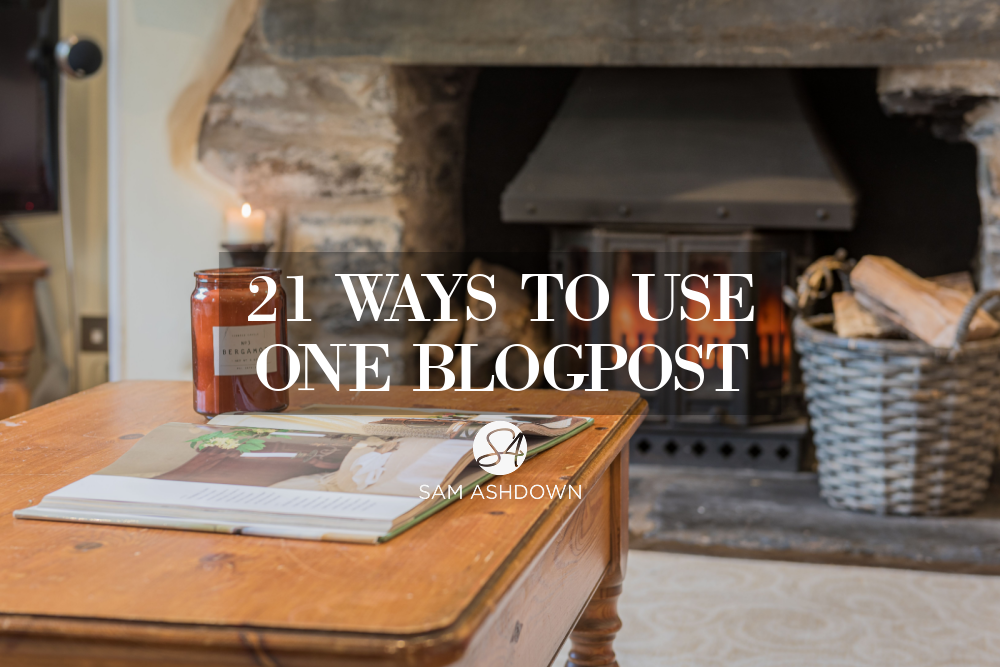So you’ve written a great blogpost, and posted it on your site. Well done. You’ve already done something that 90% of other agents won’t.
But once it’s been live a few days, how do you keep interest in it? And how do you ensure your great content reaches a wider audience than just your blog readers?
The answer is to ‘re-purpose’ your content.
Create less – promote more
Re-purposing your content gives you three main benefits over just posting your blog and forgetting it:
1. Gives you SEO juice – search engine optimisation is all about getting found on Google. When you re-purpose your content, it gets more hits to the original post, and that signals to Google it’s a link worth showing in search.
2. Reaches a new audience – not everyone wants to read text on a website. You’ll see in the list below that there are multiple ways of publishing your content that will make sure there’s something for everyone.
3. Gets your message across more strongly – if someone sees your content in several places online, and in various formats, they are much more likely to remember it, and internalise your message.
So let’s dive into my 21 ways to use ONE blogpost. And before you panic, you don’t have to try them all… well, not straight away…
1. Facebook link – just add the link to your blogpost and Facebook will do the rest. You can remove your blogpost link once Facebook has pulled through the image and meta-data. Then a reader can just click the post or your image and they will be taken straight to your blogpost.
2. Facebook long-form – this is where you post the blog in full, straight into Facebook. There’s a word limit to a post, but it’s about 10,000 words, so you probably don’t need to worry about it. The advantage of posting your article in full is that people don’t have to leave Facebook to read it. You can still add a call to action, with a link to your site, so long as it’s relevant to the content.
3. Facebook image with link – this is where you upload your image first to Facebook, then add the link in afterwards. That way, Facebook doesn’t pull through the site data. This is good to use if your site isn’t displaying the meta-data properly, but also just so you can re-post your article without it being a duplicate of your previous post.
4. Facebook image as cover with link – when you create your blogpost image, create a Facebook cover image that matches. The current dimensions of a Facebook cover image (the long one along the top of your Facebook page) are 851 x 315 pixels. When you add the title text, place it towards the middle of your image, so it displays in mobile too. Then in the cover image description, introduce your blogpost with a strong reason to click to read, and the link.
5. Facebook quick quiz just for fun or small giveaway – keep it relevant to your blogpost. For example, if your blogpost is about home staging accessories, perhaps you could give away a small scented candle, or a bunch of flowers from a local florist. Keep the entry conditions super simple and easy to enter. If you ask people to do something that requires effort on their part, like uploading a photo, you’ll drastically reduce the number of people who enter. You could just ask for a like and share, whilst this is technically against Facebook’s terms of service, it is rarely if ever enforced.
6. Facebook Live – go live! Live video has a far higher engagement rate than any other post on Facebook right now. All you need to do is set up your phone on a tripod or table, and talk to camera about your post. Perhaps you can simply go over the main points of your article, or show something you’ve referenced. Make your video at least ten minutes long to encourage live watchers.
7. Images with tips – split your blogpost up into the main points, and add each point to an image. I use www.picmonkey.com for this; it’s really easy to use and the basic plan is a few pounds a month. Once you’ve created a few of these ‘tips’ images, schedule them in Facebook to appear one each day, and introduce each one with some text. Add the blogpost url and it’s good to go.
8. Facebook ad or boost your post, or your Facebook Live video – for a very small budget, you can turn your article or post into an advert on Facebook, to reach a wider audience and attract new fans to your page. Boosting a post also raises your organic reach, giving you twice the benefit.
Twitter
9. Twitter link – post your article link on Twitter with a brief intro. Make your tweet compelling to encourage the click. Also include the image, as tweets with images are much more popular than those without.
10. Did you know? Open with a good statistic or surprising fact from your post, then add the link and image as before.
LinkedIn
11. LinkedIn link – as with Facebook, just post the link to your blogpost and LinkedIn will pull through your metadata and blogpost image, and feature it in Pulse, their version of the Facebook newsfeed.
12. LinkedIn Articles – did you know that LinkedIn has a blogging platform, right inside LinkedIn? Just go to create an update, and you’ll see ‘Write an article’ as an option. You can simply add your blog image as the header and paste your text into the relevant section. You can even add images and media, by clicking the little ‘plus’ button on the left. To encourage a click to your website, suggest a ‘what to read next’ that flows naturally from the post they’ve just read.
Other platforms and ideas
13. Pinterest– this platform is a real traffic rocket; some of my blogposts have had literally thousands of clicks from Pinterest. All you need to do is upload your blogpost image, write a short description and add the blogpost link in the box provided. Simple 🙂
14. Instagram – not so easy to use this platform to drive traffic, but if you put in the effort, it can pay off. Using the app, upload your post image directly into Instagram. You can’t do this from desktop. You’ll need to put the url to your post in your bio, then add ‘post link in bio’ in your image description. Make sure your image clearly states the blogpost title, large enough that it can be seen on a phone. Then add a handful of hashtags to make sure your post can be found. You may need to do a bit of research to find the popular property hashtags, but tags like #propertystyling #decor and #homestaging will attract some visitors to your post.
15. Slideshare – this is a platform you may not have heard of. It’s owned by LinkedIn and therefore carries the weight of their professional credibility. It’s free and quick to set up an account. They also make it super easy to share across both platforms, and you can add a slide deck to your media section within your LinkedIn profile and page. The first thing you’ll need to do is to create a slide deck from your blogpost. This is easier to do when you have a ‘listicle’ post – a post created from a list, eg ‘7 Reasons to Sell Your Home in September’. PowerPoint and Keynote are the two main applications to create your slide deck in; both are pretty easy to use. If you’re a newbie, YouTube is crammed with helpful video tutorials to show you how to do it. Once you have your slide deck, just upload to Slideshare and share across to LinkedIn and your other social platforms.
16. Video tutorial – a bit more advanced than the other re-purpose ideas, but creating a video of your slides with a voiceover can be a great way of attracting a new audience, and increasing your credibility with your current followers. For this, you’ll need screen capture software. I use Screenflow for Mac, and the pc alternative is Camtasia. Both cost over £100, but are well worth the investment, provided, of course, you actually use them. There are free versions on the web, but they will usually carry their own advertising and branding, which may detract from your professionally branded image.
17. Checklist – any kind of freebie giveaway, sometimes called a ‘lead magnet’, can both enhance your content, and increase your subscriber base. Ideally, you need to host your checklist on a landing page, free from your usual site navigation. The easiest way to do this is with a third party landing page software. I use and recommend LeadPages. In return for downloading the checklist, your reader will need to give their email address, therefore adding to your subscriber database.
18. Survey/questionnaire – you can use this to encourage engagement from your blog readers and to make sure that what you’re writing is relevant to them. There are some good free survey options available; I use Wufoo, which is free for the first few questionnaires you set up. You can also embed the form in your post, or just link to it in the text. The responses will then be sent to your email. Keep your surveys and questionnaires super short, to motivate a high response rate. For example, asking just one multiple choice question, like ‘What do you want to see more of on our blog?’ with various choices, will get a much higher response rate than asking lots of questions about their personal situation and likelihood to move home in the near future.
19. Infographic – these can be a great way of presenting your content in a highly visual and colourful format. They also work well on Pinterest, where you can get inspiration from yours from the many that are featured on there. You can either create your infographic yourself (just Google free infographic tools), or else use a freelancer site like www.Fiverr.co.uk where you’ll be able to commission one for around £20- £40.
20. Email – let’s go old school here: don’t forget to actually email your list with your blogpost! Give them the first paragraph or two, together with a compelling reason to click, add a hyperlink and include your blogpost image. Make that clickable too, and add a PS with the full link in case the hyperlink in the email doesn’t work.”
21. e-guide/cheatsheet – this is easier than you might think. Once you have created your slide deck, simply save your slides as a pdf and you have an e-guide! Add it to a landing page, turn it into a Facebook ad, and promote it on all your social media platforms with a link back to the original blog. It’s a really simple and effective way of creating a digital asset for your business that you can use time and time again.
This is not an exhaustive list (though it may look exhausting!) – there are many more ways you can use your original content to get more traction and reach: turning it into an audio file, creating a press release, making an in-person presentation – and we haven’t even mentioned YouTube….
How our happy band of amazing agents can help you grow your agency Trying new marketing tactics that your competitors can’t, won’t and don’t is not easy. Having the support of agents who have been where you are now, and breaking revenue barriers you want to one day achieve yourself, is vital. That’s why we created the AJ Mastermind.
Not only will you get to spend time with people who will lift you up and help you get to your goals, the AJ Mastermind also gives you access to the very best estate agent marketing, training and coaching in the country.
Click the big gold button below to take a look for yourself, and let’s see if we’re a good fit for one another.




